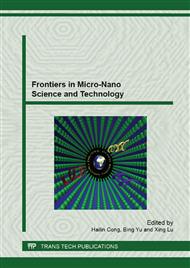[1]
S. Nie, S.R. Emory, Probing single molecules and single nanoparticles by Surface-Enhanced Raman Scattering, Science. 275 (1997) 1102-1106.
DOI: 10.1126/science.275.5303.1102
Google Scholar
[2]
J.F. Li, Y.F. Huang, Y. Ding, Z.L. Yang, S.B. Li, X.S. Zhou, F. R. Fan, W. Zhang, Z.Y. Zhou, D.Y. Wu, B. Ren, Z.L. Wang, Z.Q. Tian, Shell-isolated nanoparticle-enhanced Raman spectroscopy, Nature. 7287 (2010) 392-395.
DOI: 10.1038/nature08907
Google Scholar
[3]
D.J. Maxwell, J.R. Taylor, S. Nie, Self-Assembled nanoparticle probes for recognition and detection of biomolecules, J. Am. Chem. Soc. 124 (2002) 9606-9612.
DOI: 10.1021/ja025814p
Google Scholar
[4]
J.M. Sylvia, J.A. Janni, J.D. Klein, K.M. Spencer, Surface-Enhanced Raman detection of 2, 4-dinitrotoluene impurity vapor as a marker to locate landmines, Anal. Chem. 72 (2002) 5834-5840.
DOI: 10.1021/ac0006573
Google Scholar
[5]
L.L. Qu, Y.T. Li, D.W. Li, J.Q. Xue, S.F. John, Y.T. Long, Humic acids-based one-step fabrication of SERS substrates for detection of polycyclic aromatic hydrocarbons, Analyst. 138 (2013) 1523-1528.
DOI: 10.1039/c2an36764e
Google Scholar
[6]
Y. Gao, P. Jiang, L. Song, J.X. Wang, L.F. Liu, Studies on silver nanodecahedrons synthesized by PVP-assisted N, N-dimethylformamide (DMF) reduction, J. Cryst. Growth. 289 (2006) 376-380.
DOI: 10.1016/j.jcrysgro.2005.11.123
Google Scholar
[7]
M.J. Mulvihill, X.Y. Ling, J. Henzie, P.D. Yang, Anisotropic etching of silver nanoparticles for plasmonic structures capable of single-particle SERS, J. Am. Chem. Soc. 132 (2010) 268-274.
DOI: 10.1021/ja906954f
Google Scholar
[8]
L.H. Lu, A. Kobayashi, K.K. Tawa, Y.K.H. Ozaki, Silver nanoplates with special shapes: controlled synthesis and their surface plasmon resonance and surface-enhanced Raman scattering properties, Chem. Mater. 18 (2006) 4894-4901.
DOI: 10.1021/cm0615875
Google Scholar
[9]
W.E. Doering, S.M. Nie, Spectroscopic tags using dye-embedded nanoparticles and Surface-Enhanced Raman Scattering, Anal. Chem. 75 (2003) 6171-6176.
DOI: 10.1021/ac034672u
Google Scholar
[10]
L. Brenda, G. Sanchez, S. Pattanawit, T.J. Lamkin, R.J. Hickey, Z. Fakhraai, S.H. Link, S.J. Park, Spiky gold nanoshells: synthesis and enhanced scattering properties, J. Phys. Chem. C. 116 (2012) 10318–10324.
DOI: 10.1021/jp300009b
Google Scholar
[11]
Y.G. Sun, Y.N. Xia, Shape-controlled synthesis of gold and silver nanoparticles, Science. 298 (2002) 2176-2179.
DOI: 10.1126/science.1077229
Google Scholar
[12]
D.H. Seo, C. Yoo, I.S. Chung, S.M. Park, S. Ryu, H. Song, Shape adjustment between multiply twinned and single-crystalline polyhedral gold nanocrystals: decahedra, icosahedra, and truncated tetrahedra, J. Phys. Chem. C. 112 (2008) 2469-2475.
DOI: 10.1021/jp7109498
Google Scholar
[13]
Y. Yang, J. Shi, G. Kawamura, M. Nogami, Preparation of Au–Ag, Ag–Au core–shell bimetallic nanoparticles for surface-enhanced Raman scattering , Scripta Mater. 58 (2008) 862-865.
DOI: 10.1016/j.scriptamat.2008.01.017
Google Scholar
[14]
W.E. Pereira, D.L. Short, D.B. Manigold, P.K. Roscio, Isolation and characterization of TNT and its metabolites in groundwater by gas chromatograph-mass spectrometer-computer techniques, Bull. Environ. Contam. Toxicol. 21 (1979) 554-562.
DOI: 10.1007/bf01685469
Google Scholar
[15]
M.M. Laura, T. Pete, H.H. Herbert, Evaluation of suspected interferents for TNT detection by ion mobility spectrometry, Talanta. 54 (2001) 171-179.
DOI: 10.1016/s0039-9140(00)00663-9
Google Scholar
[16]
J.S. Yang, T.M. Swager, Fluorescent porous polymer films as TNT chemosensors: electronic and structural effects, J. Am. Chem. Soc. 120 (1998) 11864-11873.
DOI: 10.1021/ja982293q
Google Scholar
[17]
E.M.A. Ali, H.G.M. Edwards, I.J. Scowen, Raman spectroscopy and security applications: the detection of explosives and precursors on clothing, J. Raman Spectrosc. 40 (2009) 2009-(2014).
DOI: 10.1002/jrs.2360
Google Scholar
[18]
S.S.R. Dasary, A.K. Singh, D. Senapati, H.T. Yu, P.C. Ray, Gold nanoparticle based label-free SERS probe for ultrasensitive and selective detection of trinitrotoluene, J. Am. Chem. Soc. 131 (2009) 13806–13812.
DOI: 10.1021/ja905134d
Google Scholar


